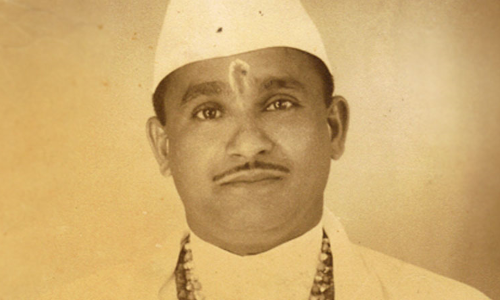On the occasion of Fathers’ Day, the following is a tribute to the late Shankaracharya Pt. Hari Prasadji, the founding father of SWAHA, as related in speeches at SWAHA’s recent 25th anniversary celebrations by Pt. Gyandeo Persad, Chairman of the SWAHA Dharma Mandal and Spiritual Leader of Sukh Shanti Bhakti Mandali and Dharma Jyot Mandali and Pt. Manideo Persad, senior member of the SWAHA Dharma Mandal, Spiritual Leader of SWAHA Shri Raam Dhaam and Director of SWAHA Media.
Shankaracharya’s Values
SWAHA is a creation of Shankaracharya and Maataaji, Pt. Hari Prasad and Chandroutie Persad. Without them, there would’ve been no Swaha. What they stood for and represented has been transmitted to create the ethos of what SWAHA believes in. What are the values they taught? What were the values the Shankaracharya believed in? Respect for elders, care for others without discrimination, love for country, love for Hinduism, India and Indian culture. In his life, the Shankaracharya would have made over 28 pilgrimages to India.
The Shankaracharya believed in charity. Every single temple of SWAHA, every single institution of SWAHA was built in part with the financial contributions of the Shankaracharya. In fact, even before SWAHA was formed, the Gyaan Deepak Kirtan Mandali was completed with funds that he provided. He represented, together with Maataaji, a capacity for hard work and he believed in education. He saw the need for education to achieve independence.
-Pt. Manideo Persad
Shankaracharya: The Journey to Divinity
In the Bhagavad Gita, chapter 9, verse 26, Shree Krishna Bhagavan says:
Patram pushpam phalam toyam yo me bhaktyaa prayachchhati
Tadaham bhaktyupahritam ashnaami prayataatmanah
“If one offers to me, a leaf, a flower, a fruit or water with devotion,
I will accept that offering from that pure-hearted devotee.”
The Shankaracharya offers an inner meaning to this verse. Patram means ‘leaf’. He said that in ancient India, scriptures were made from the bhojpatra tree, a tree that grows in the Himalayas. Patram here means the scriptures written on leaves. So, those who read the scriptures, understand the scriptures and learn the scriptures, they are worshipping me.
Pushpam means ‘flowers’. Pushpam also means the flowering of the crown chakra (an energy centre within the body), the chakra at the top of the head, the sahasrara chakra. This chakra, depicted as violet in colour, is the 1,000-petalled lotus flower. We have to offer that flower to the Supreme Lord. How do we reach there? We start from the muladhara chakra (chakra at the base of the spine) and go up. So, we start from Ganeshji to Gauri Maataa, Shivji and Krishenji. That is the journey to take us up to the sahasrara chakra. Shankaracharya said that the flower you have to offer is the sahasrara chakra at the top of the head, the brain, the highest chakra in the body.
Phal means fruit. This is not just apples, grapes and pears. In chapter 3, verse 28, Bhagavan Shree Krishna said: “Who offers all actions to me, the result of your actions are indeed blessed.” So we have to offer the fruit of our actions to Bhagavan.
Toyam is water. Devotees like Shabari in the Ramaayan washed Shree Raam’s feet with the tears from her eyes. Do your tears flow for the Lord? Do you feel that emotion?
This is the philosophical meaning of that phrase. Shankaracharya said that we have to read and listen to the scriptures, know the scriptures and engage in spiritual practice and raise that energy power to the highest chakra. Offer all actions to God, and do so with devotion, with love and tears in your eyes. An intellectual person can put meaning to a katha (story), but only a bhakta (devotee) can experience divinity. Put your love in the Lord to experience bhakti (devotion).
– Pt. Gyandeo Persad



